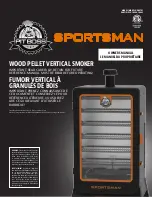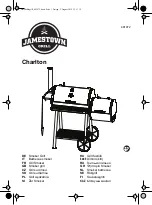
Document NO.: RD-529-39-001
Version: A
- 1 -
EN14604:2005/AC: 2008
Smoke Alarm User Manual
Model number: GS529
Ref
:
ST529
Thank you for purchasing our smoke alarm
with wireless and
heat detection. Please take a few minutes to read the user’s
manual thoroughly and familiarize yourself and your family
with its operation. And save it for future reference.
Diagram 1
Product Specifications:
Power
:built-in DC3V(CR17450) Lithium battery
(battery
can be replaced.)
Operation current
:
≤
90mA
Alarm volume
:
≥
85dB(A) at 3 meters.
Smokesensitivity
:0.09-0.15dB/m
Local smoke alarm sound pattern:
BI 0.5s - pause 0.5s – BI 0.5s – pause 0.5s – BI 0.5s –
pause 1.5s- BI 0.5s - pause 0.5s – BI 0.5s – pause 0.5s
– BI 0.5s – pause 4.5s, with the red LED flashing
every 1 second, repeat this alarm pattern.
.
Wireless alarm pattern:
Bi 0.2s - pause 0.1s - Bi 0.2s - pause 1.2s, with the
red LED flashing every 1.0 second, repeat this alarm
pattern.
Description:
This unit is a photoelectric 3V DC smoke alarm. It is
operated by
DC 3V(CR17450) lithium battery
. With the
photoelectric technology, it is more sensitive in detecting
slow smoldering
fires which generate light smoke, little heat and may smolder
for hours before bursting into flames. This smoke alarm does
not contain any radioactive material. Smoke alarms should be
installed in every room (except the bathroom and kitchen),
finished attics and basements, making sure the people in the
home will be able to hear and respond to the alarm sound.
For minimum protection, you should install an alarm on
every level of the home particularly outside sleeping rooms.
Each alarm should be placed in the middle of the ceiling of
each room to be protected. Typical single storey dwelling
installation recommendations: Install a smoke alarm on the
ceiling inside each bedroom and in the hallway outside each
separate sleeping area. If a bedroom area hallway is more
than 30 feet long, install a smoke alarm at each end. If there
is a basement: install a smoke alarm on the basement ceiling
at the bottom of the stairwell. Typical multi-storey dwelling
installation recommendations: Install a minimum of one
smoke alarm on each occupiable level of the home. Install a
smoke alarm on the ceiling or wall inside each bedroom and
in the hallway outside each separate sleeping area. If a
bedroom area hallway is more than 30 feet long, install a
smoke alarm at each end install a smoke alarm at the top of a
first – to- second floor stairwell.
Important Safety Information:
1:The test button accurately tests smoke alarm functions. Do
not use any other test method. Test smoke alarm weekly to
ensure proper operation.
2:If you're sure it isn't a really alarm, open windows or fan
the air around smoke alarm to reset and silence it.
3:User to install this product needs to comply with all local
and national electrical installation and building codes.
4:This smoke alarm is designed to be used inside a single
family home only. In multifamily buildings, each individual
living unit should have its own smoke alarms. Do not
install in non-residential buildings as this smoke alarm is
not a substitute for a complete alarm system.
5:Install a smoke alarm in every room and on every level of
the home. Smoke may not reach the smoke alarm for many
reasons. For example, if a fire starts in a remote part of the
home, on another level, in a chimney, wall, roof, or on the
other side of a closed door, smoke may not reach the smoke
alarm in time to alert household members. A smoke alarm
will not promptly detect a fire except in the area or room in
which it is installed.
6:Smoke alarm may not alert every household member every
time. The alarm horn is loud in order to alert individuals to

























